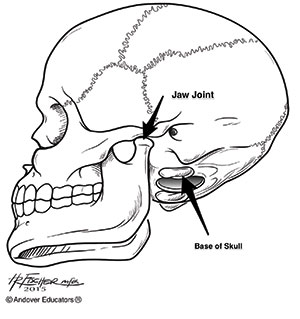Question: When breathing, should I move my jaw or tilt my skull back?
Answer: For those who have had braces, you may have been taught by the orthodontist that you have two jaws – the upper jaw and the lower jaw. The upper jaw moves with your skull, so you can also think of this as the upper teeth. The skull balances on the spine so the lower jaw is the easier bone to move to take a breath
From a freedom of movement perspective, I advocate moving the jaw because it creates less tension than moving the skull back. The jaw hangs off of the skull and is very mobile. The flute rests against the chin which is also part of the jaw. Permitting the lower jaw to open and allowing air to enter the mouth is the fastest way to get a quiet breath. The mouth should open just enough to get a decent breath quickly, but not enough to place tension in the neck muscles.
If you choose to stabilize your jaw against the flute and move your skull back when you take a breath, strain is placed on the muscles at the back of the neck and skull and in the front of the neck. The backward movement of the skull can also put strain on the upper back muscles which makes it harder to move the arms and fingers.
This movement also seems to cause students to bring their head to the flute rather than bringing the flute to the head. Many teachers call this turtlenecking and don’t want their students to do this.
It can also cause tension in the tongue, the front of the throat, and the front of neck, which makes it more challenging to breathe in a longer passage. Have you ever noticed that your first breath felt easier than the following ones? Your teacher may also tell you to open your throat because of noises you may be making when you breathe.
All in all, it is a much easier movement to keep the skull free and easily balanced on the spine, and then permit the jaw to move and allow air to come rushing in.

Try This:
Experiment with a long tone exercise. As you need a breath, take the time to permit your jaw to open and the air to rush in. Notice what your tongue is doing when you inhale. Make sure you are letting your tongue be very free and easy. Many wind players move their tongue back, as if they are trying to inhale their tongue along with the air. Let your tongue be and permit easy movement of the jaw. Notice the ease with which you can get a quiet, full breath.






